Curcuma pathuma
Curcuma pathuma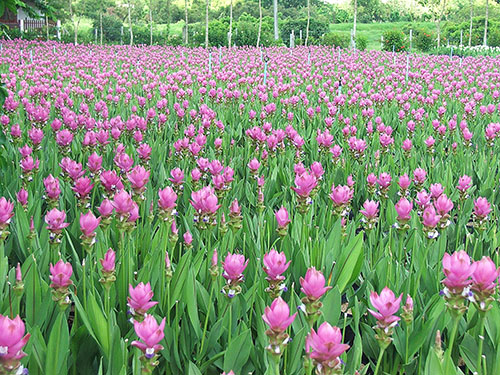
Pathuma field of flowers
The word pathuma was first used over 60 years ago to describe a plant now known outside Thailand as the Siam Tulip.
However, the pathuma plant is not a tulip but a common ginger and turmeric (Curcuma alismatifolia) family member. The tropical plant was spotted and eventually named Siam tulip by foreign tourists who first came upon it by a guti (monastic cell) in Chedi Luang Temple sometime in the 1960s. The pathuma's long elegant stem and complex delicate pinkish bracts, when grown in a field of green, resembles tulips in the wild, hence the name the Siam Tulip.
This versatile plant and its flowers brighten places of worship, are used in ceremonies, special occasions or as decoration in vases or grown in potted plants. As a result, it is sought worldwide by the global flower industry, and the Siam tulip is second only after the famed orchid, Thailand's largest floral export. It is not simply the flower itself, but also the bulb, which is generating high demand, especially in the west and particularly in the United States.
Native to the north, central, northeastern and southern regions of Thailand, the Siam tulip belongs to the Curcuma family, of which there are 33 species in Thailand within two genera, resulting in multiple common and colloquial names.
However, what is little known is that a team of researchers from Chiang Mai University's Faculty or Agriculture have been working on selective breeding and improvement of the Siam Tulip for the last 30 years.
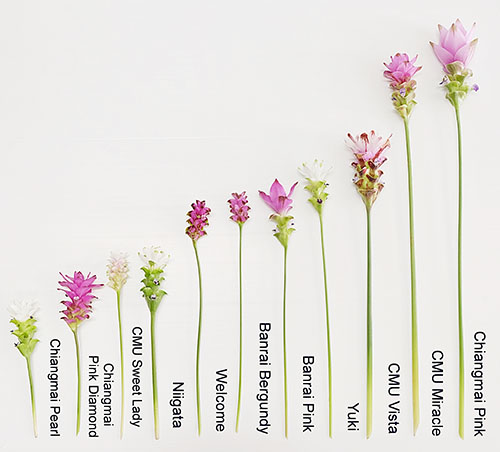
Ban Rai's development of path lima variants
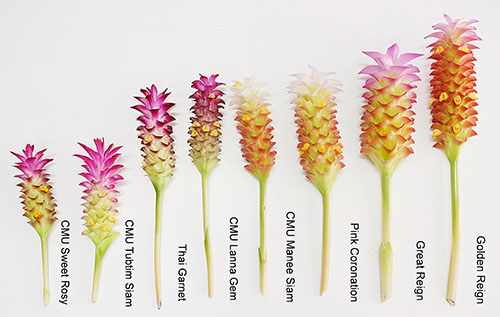
Ban Rai's development of path lima variants
Alter flower to natural innovation
Phya Winitwanandon father of Thai botany first discovered the pathuma flower while visiting the northeastern region of Thailand. His wife subsequently offered the flower to Pra Kru Winaikhosol, the abbot of Wat Chedi Luang, Chiang Mai, in 1957. Around that same time Assistant Professor Dr. Pisit Woraurai, ex Dean of Chiang Mai University's Faculty of Agriculture became acquainted with Lady Bubphan Nimmana Haeminda, who invited him to visit Pra Kru Winaikhosol. It was during this visit that he first encountered the flower which the abbot had named pathuma. Fascinated, he began to study the flower.
Eleven years later, when Assistant Professor Dr. Pisit received his doctorate and began his career as a lecturer at Chiang Mai University, the pathuma flower was already being sold at various flower markets across Chiang Mai. Assistant Professor Dr. Pisit was the first in Thailand to offer classes in bulbs, tubers and corms, and he began to collect pathuma from across Thailand, selecting and breeding them alongside Associate Professor Dr. Pimchai Apavatjirut and Dr. Chunthana Suwanthada. Once the Royal-initiated "Fruit and Flower Propagation Development Service Centre "at Ban Rai was formed, the breeding of pathuma began in earnest, with Assistant Professor Dr. Pisit, who was the programme's first director working with Associate Professor Dr. Pimchai and Professor Dr. Soraya Ruamrungsri, Director of H.M. The King's Initiative Centre for Flower and Fruit Propagation under Chiang Mai University's Faculty of Agriculture's Department of Plant and Soil Sciences.
"Every time I teach horticulture or flowers and bulbs, at the mention of pathuma I feel the urge to tell its story to my students," said Professor Dr. Soraya.
"I tell them about our very own Assistant Professor Dr. Pisit's discovery and instill pride in them that this flower was essentially born from Chiang Mai University and has since been a gift to many Thai farmers. If Assistant Professor Dr. Pisit had not decided to develop the flower, it would not be in today's world market. Therefore, I can say unequivocally that pathuma was born from the power of our university's researchers.
When His Majesty King Bhumibol Adulyadej told Assistant Professor Dr. Pisit that pathuma is of great value to the Thai people, it drove us to expand our scope of work to improve the species. As a result, today there are multiple researchers from institutions across Thailand working on various breeds and variants of pathuma, producing a great variety of new flowers."
Royal-initiated Fruit and Flower Propagation Development Service Centre at Ban Rai
Situated in the Hang Dong District of Chiang Mai Province and known as the "Queen of the Rain Jungle," the Royal-initiated "Fruit and Flower Propagation Development Service Centre" at Ban Rai is the epicentre of the pathuma empire.
Researchers, faculty members, and the student body work together to develop pathuma, gladiolus, and other tropical floral plants. The aim is to create tangible benefits to the public through research, in line with H.M. King Bhumipol's ideas and wishes with four points to the compass which include the four aims: 1. Helping the people have a better quality of life and higher income, 2. Help solve problems associated with the production of flowers, enhancing the knowledge base of current farmers, 3. Reach the point where farmers can continue to develop in a sustainable manner, 4. Help with conservation of quality Thai flowers.
Assistant Professor Dr. Pisit worked on a variety of plants at Ban Rai, starting with gladiolus, which he gave to a group of farmers in Chom Thong District to experiment with, eventually turning Chom Thong into a large grower of gladiolus, which caught the attention of H.M. the king.
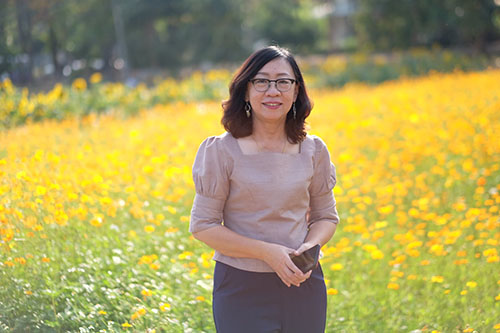
Professor Dr. Soraya Ruamrungsri, Director of H.M. The King's Initiative Centre for Flower and Fruit
Propagation under Chiang Mai University's Faculty of Agriculture's Department of Plant and Soil Sciences
Upon visiting the project in Chom Thong in 1975, H.M. King Bhumipol told Assistant Professor Dr. Pisit, "This work is of great benefit to the people. Do not stop; please continue and invite more lecturers from the university to work towards finding ways to help the people."
Pathuma and Curcuma nursery
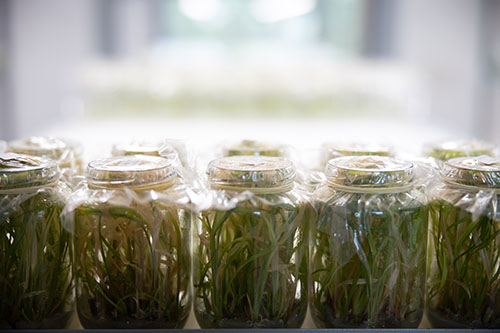
Tissue breeding
In 1980, H.M. King Bhumipol donated 80,000 baht to help Assistant Professor Dr. Pisit solve the most challenging problem facing Thai farmers: the lack of access to quality plants. To this day, Ban Rai's primary focus is study, experiment and to research for real results that benefit the public.
Following the directions laid down by H.M. King Bhumipol, both gladiolus and pathuma are now successfully exported worldwide. Pathuma reached global recognition in 1975 when Assistant Professor Dr. Pisit bred a sub-species called Chiangmai Pink, which he took to Japan, to much acclaim.
Today pathuma is grown by small farmers and big investors in six provinces: Chiang Mai, Phayao, Nakhon Nayok, Chachoengsao, Yala, and Narathiwat, generating 18 million baht in 2020. Each year Thailand exports around 30-40 million baht worth of pathuma to the world market. It is estimated that the global pathuma demand could be as much as 200 million baht per year. However, world floral trends, like fashion, are unpredictable and in constant flux, meaning that researchers must be on alert at all times.
"If a plant is still in demand, then farmers will not stop growing it” said Professor Dr. Soraya. "This means that we have to constantly innovate and develop new species and variants to have more to offer the market.
The Ministry of Commerce has stepped in to help find markets. While the pathuma market is only a fraction of the tulip market, they share many similarities. However, it is a concern that if pathuma is only known as Chiangmai Pink, its popularity may wane. Therefore, we must continue to find new developments."
Pathuma has enjoyed a fascinating journey from its humble roots in the northeastern region of Thailand. Having been discovered as a potted plant in a temple 60 years ago, it is now a plant with global demand.
This beautiful flower now exists in a variety of species and variants. Grown best at Ban Rai, the only place where the flower blooms year-round, the pathuma has many impressive qualities. Of particular importance to growers is the predictability of exactly when it will bloom.
Pathuma's story is far from over. Continuous research and farmers' hard work have created a beautiful union between nature and man. With a growing market for this wonderful plant, pathuma may still have a significant role to play in Thailand's future economy.